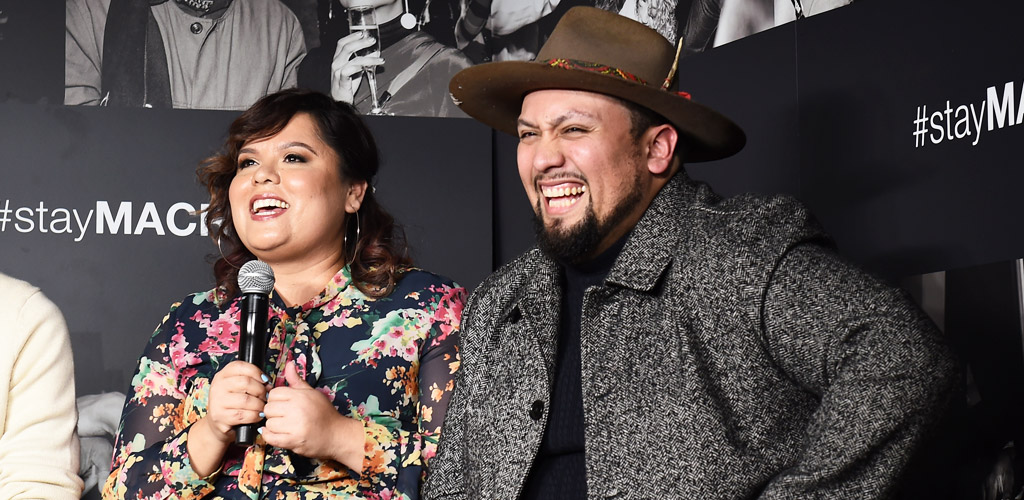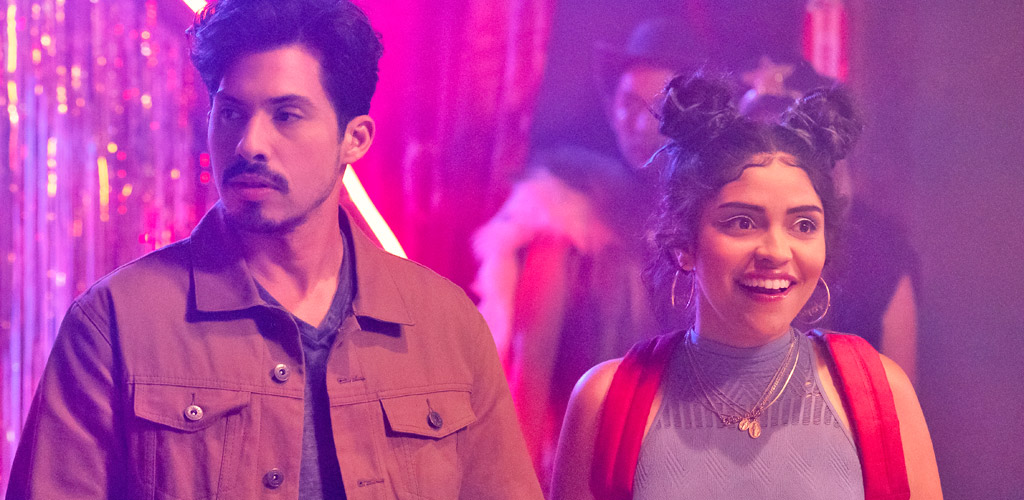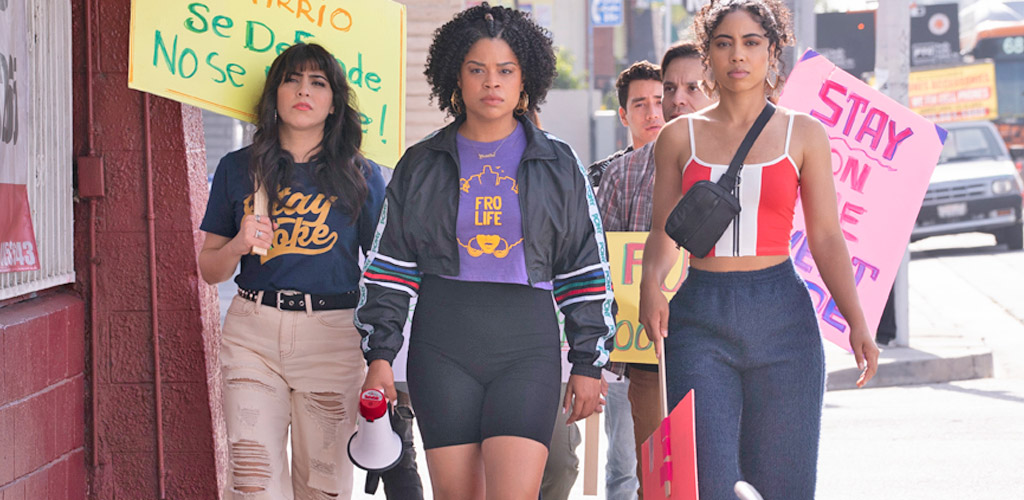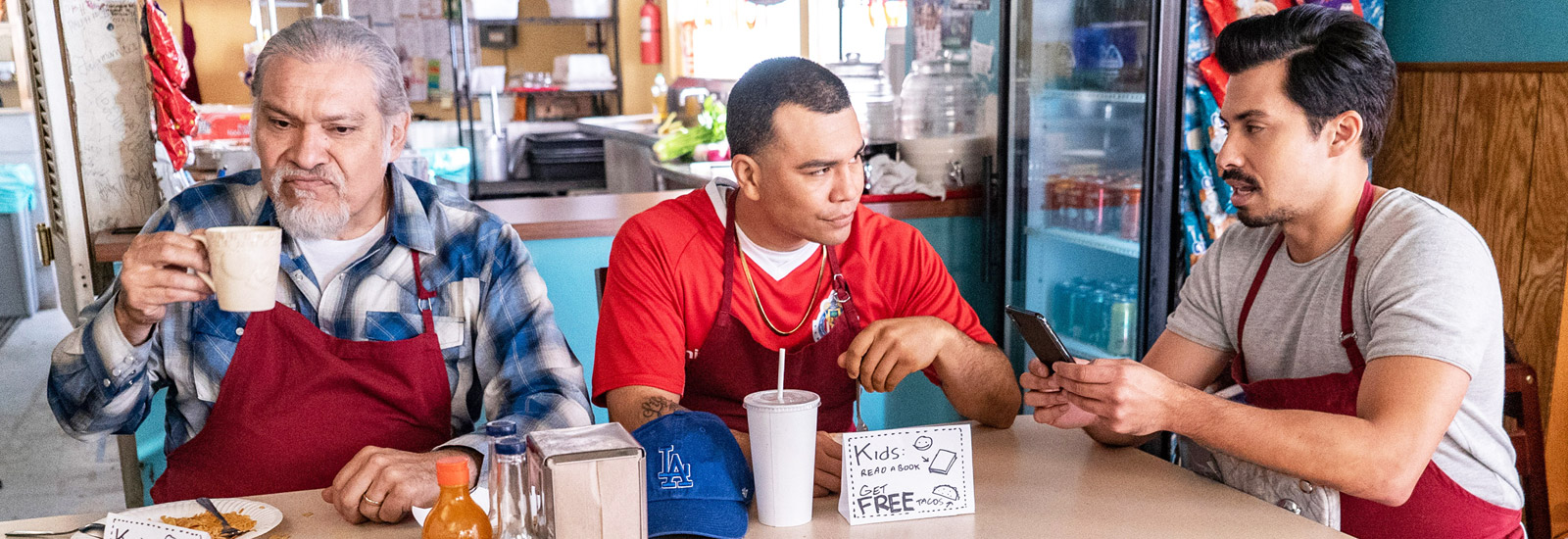Gentefied‘s first season is launching on Netflix after being developed from a digital series that premiered at the 2017 Sundance Film Festival. Now, creators Linda Yvette Chavez and Marvin Lemus (who also write and are joined as executive producers by America Ferrera) are continuing their exploration of Mexican-American identity with one badass dramatic comedy show. The project is a love letter to the Latinx community that upholds the Boyle Heights neighborhood of Los Angeles, and the characters find themselves at the center of a swiftly changing LA as a family attempts to keep their taco shop afloat. During the course of that challenge, a trio of cousins and their immigrant grandfather struggle to wrap their arms around the American Dream.
That dream, of course, pursues success, which might be a double-edged sword that threatens the communities and values that the family’s hoping to help preserve. Is success part of the problem that actually works against their community? Gentefied is both reflective and visionary in that regard, given the show’s name originates from a term coined in Boyle Heights. In other words, “Gentefied” refers refers to how residents (often Latinos) improve their businesses to stay afloat, but that process attracts outsiders who move into the neighborhood, at the expense of people who should be the beneficiaries.
Gentefied is a charming series full of authentic characters who people will adore. It’s quick-witted and funny and fierce and, at times, heartbreaking. Chavez and Lemus were gracious enough to sit down with us and explain more about Boyle Heights’ cultural and historical significance, along with details on how the Netflix series came together.

First off, I wanted to thank you for these perfectly distilled 30-minute episodes because this show delivers the opposite of many bloated series.
Linda Yvette Chavez: Ohhh, thank you so much for that.
Marvin Lemus: That’s really wonderful, and it means a lot.
Did you have a major decision-making process to land on half-hour episodes?
Marvin: No, I think we just worried about the story, and with Netflix, we didn’t have to worry about commercial breaks. We always wanted to try to keep them under 30 minutes. There were a few episodes that went over, but Linda and I come from short-form, digital films, and we loved trying to keep things as airtight as possible. I joke about my director’s cuts being shorter because I love to make things as airtight as they can get, deleting and cutting things if they really aren’t part of the story. So especially with comedy, we’re very focused on the pacing and making sure there’s a good tone and rhythm, but it was all ultimately dictated by story. With that as the primary focus and our inherent rhythm, I think everything ended up the length that it needed to be.
For those who aren’t familiar with what Boyle Heights represents, can you explain why you chose this backdrop?
Linda: Absolutely. Boyle Heights is a character in the story, and they are one of the most unapologetic communities that you will ever meet. They’re so passionate about their neighborhood and their identity in the neighborhood, and they’re also the home of the Chicano movement in the 1970s. There’s so much history in that area and activism. A lot of my family grew up in that area, and that was like the mecca for Mexican culture in LA. It feels like coming back home, and [it’s] really fighting for itself with passion that’s so ferocious and beautiful. It’s really a metaphor for this identity that people who are children of immigrants deal with all the time. We’re not Mexican or American enough, or we’re between worlds. We’re trying to reconcile these worlds and stand strong in our identity, in being Mexican-American or Chicano, there’s a representation of that there. And they’re just at the forefront of the gentrefication movement. The activists are so incredibly fierce and powerful and organized, and they’re creating movements.
Marvin: And they’re connecting with other organizations and community members and other communities that are dealing with the issues like Chicago and New York. The way that they move through space! The reality is that without the work that they’ve been doing, Boyle Heights could have already been just like Echo Park and Silver Lake. It could have shifted that dramatically, but it has held onto who they are, and it hasn’t changed as dramatically or quickly because of those efforts. That’s a lot of why we loved and wanted to explore the story through Boyle Heights.
You said that in this show, the stories came first. Where did the cultural messages figure into overall planning?
Linda: I think we were thinking more about themes and characters when we were working on it. The “gentefication” theme was there from the beginning, but when Marvin and I got together to develop the digital series, the initial characters, we definitely were thinking about how we wanted to tell stories that we wanted to see about our community and our people. So we always joked when we started writing this world that we were trauma bonding. It was like our therapy, and we put so much of ourselves, our ideals, our dreams, our cousins, our grandparents, into the work because we were talking about identity. We were talking about things we were dealing with through, being first-generation Chicano immigrants and trying to choose the American dream, that’s so individualistic and very much about reaching goals and money while still trying to maintain that connection to our family and our cultural values. It felt like they were in contradiction to each other, and so we started to think about the themes and the world and the identity issues that came into play, that’s really where it came from. It came from us sitting down and talking about our own issues and families and relationships.
Marvin: Because there’s so many questions and issues that we’re tackling, we knew that we really needed to boil it down. We really focused on distilling down our core theme that would encompass everything. What we always came back to was the theme of community versus self. And community, meaning the neighborhood or family, versus yourself and your own wants and desires and how they directly compete. We’d always come back to how the show was reflecting that theme and keeping us on track and streamlined. And every character, the cousins and Pop, they are all on a spectrum of being more community-oriented or more individualistic. You can see it most clearly in Eric and Chris and how they’re polar opposites on that spectrum. Ana’s sort-of in between them where she’s family first but also wants some of that individualism. That was a big part of how we focused on our story to make sure we were able to not get too bogged down in weeks of what we were tackling.

Speaking of Ana (portrayed by Karrie Martin), she’s such a lively and lovely character. Why did you decide to make her an artist?
Marvin: We wanted to explore the issue in this community through different points of view. Linda and I are both artists, and I think that the struggle that Ana goes through with being an artist that wants to have a career and success and how that directly competes with values and virtues and activism, it’s really something that Linda and I were experiencing. That struggle of us making the show and use our storytelling as activism, to amplify social injustices and causes that we’re very adamant and passionate about and how that can compete with being in a capitalistic system. And can these things coexist and be balanced. We were able to use her role in the show (and Chris, the culinary artist) to explore those personal questions and conflicts.
Can we talk about the artist who did Ana’s paintings?
Linda: Yeah, the artist is Emelia Cruz, she’s a Chicana artist from (I believe) The Valley. I was following her and obsessed with her art. She just captured that identity that we’re talking about so beautifully. So with Ana, when we were trying to decide who should be the artist, I told Marvin, “Oh my god, should we hire Emelia Cruz?” And he said, “Absolutely.” We both really felt like her art feels like something that could be in a museum somewhere because it’s so beautiful and saying so much and so detailed. We wanted people to see that Ana was a street artist and stuff, but she has the potential to go so far that you want to root for her.
Marvin: Yeah, Linda and I are constantly PMing each other all kinds of things that we find online. Artists and music and graphic designers and photographers from the community because we’re passionate about it, and they inspire us and could be something or someone that becomes involved in the show and our work and the community that we’re building of artists. Emelia was someone for whom I became an immediate fan. I had been following her too. Her art is so gorgeous. Her stuff is so detailed, but we were on a tight timeline, and she was able to turn around the custom pieces that she made for us in a short amount of time. It was so worth it, and we’re so excited to hopefully boost and amplify her work.
Joaquín Cosio, who was recently seen in Narcos: Mexico, is such a revelation as Pop. How did you guys snag him for the show?
Marvin: We were very adamant about Pop being an amazing, dramatic, Mexican actor. Somebody that could have that toughness and be the grandfather who could still kick your ass and have this big heart of gold and be this teddy bear. One of the most important things is that we needed him to be Mexican with a real Mexican accent, not an actor putting on an accent. We wanted to hear him authentically. We saw so many actors come in and read for us, but we were finding it difficult to check all the boxes, and this was such an important character that is the heart of the show. By the end, the casting director [Carla Hool] was probably ready to kill us, but she said, “Okay, I know this actor, he usually plays bad guys, he does drama, but he also does a lot of comedies, and he’s a huge star in Mexico. He’s got a Visa.” That was one of the challenges.
Linda: We saw his reel, and we thought that this guy was everything that we’d been looking for. We sent him the script, and he loved it. We called him on Skype, and it was love at first sight. We were just so enamored with him, and we talked in Spanish, and then he would try it in English. With the script, he thought it was so powerful. We told him about the character and storylines, and he just felt so connected and inspired to play the role. It was different than a lot of the roles that he normally plays, and we could see in him the type of grandfather that we grew up with or had hoped for. He’s such a teddy bear, even though he plays such intense characters, but we love him so much.
Marvin: He’s a sweetheart, and the whole cast looks up to him, and they’ve all become family. Even though he’s not as old as he plays in the show, but he’s just this father figure, including to us. He lights up the room, and he’s the best.
The finale hits pretty hard with a big open-ended question that’s left dangling. No spoilers here, but do you have a second season plotted out?
Linda: We have ideas and thoughts, and there was some plotted out in advance when we went in to pitch the series, but then as we created and wrote the series with the other writers and showrunner, we’ve gotten more ideas. So I think we have starting points, so we’re excited to play, but we have a lot of hopes and dreams for the characters and ways that we want to see them depicted in the most authentic and powerful ways because they all represent real people who are out there doing real work and facing real challenges.
Marvin: At the end of the day, it all comes back to what we talked about earlier: the theme that we’re exploring. We might expand beyond community versus self. We’re thinking about a couple of directions that might help us unpack and dig deeper with the issues and questions that we’re asking.
Netflix’s ‘Gentefied’ is currently streaming its first season.








